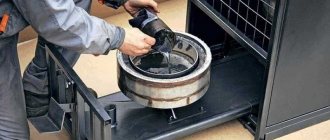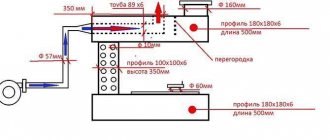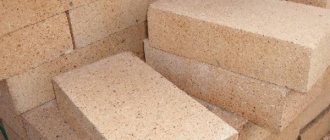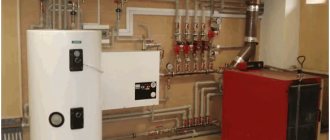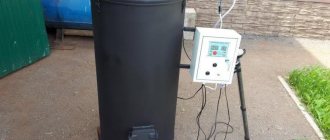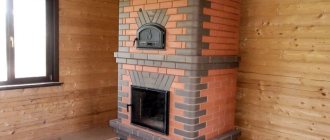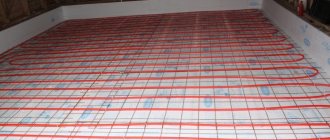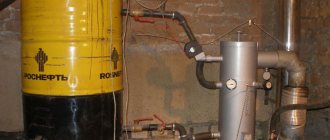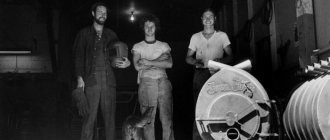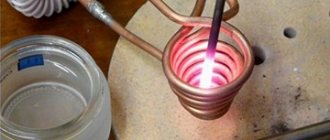A heating boiler using waste oil as fuel is one of the most efficient designs and is a fairly affordable device. It can be used to maintain a certain temperature in rooms of completely different functionality.
It is worth noting that the waste oil used in such a boiler has a fairly high level of performance, and its cost is low, so such a boiler will be quite economical.
Boilers running on waste oil have a large number of different positive characteristics:
- This heating boiler can be completely assembled independently , without turning to professional developers in this area;
- Its design is so simple that it does not require serious financial investments;
- Waste oil is one of the cheapest types of fuel used in boiler rooms;
- There are not too many parts of this type in standard boilers , due to which the likelihood of their failure is quite low.
- The boiler does not take up much space and is a fairly compact design;
- It can be installed even indoors without fear of combustion products getting there. This is due to the fact that the boiler has a closed casing;
- Absolutely any used engine oil can be used as fuel
- It is a completely comfortable device , since due to its design no unpleasant odors are formed.
Operating principle of the boiler
A heating boiler operating on waste oil operates based on a number of factors. The installed oil deposit takes the required amount of fuel from the supply tank and transfers it to a special evaporation chamber.
In essence, it is a standard metal pipe. It is worth noting that for this purpose it is best to take a pipe with fairly thick walls so that it can withstand the highest possible temperature.
To make used oil suitable for use in the heating system, it is brought to a temperature of 40 degrees. When fuel hits the bottom of the chamber, it gradually begins to evaporate, becoming oil vapor, which subsequently rises into the combustion chamber.
When assembling such a boiler, be sure to take into account that any system that operates using waste oil must be equipped with a heating system. If you neglect this point, the used oil will not reach the required temperature.
This will lead to poor ignition of the fuel in the future; it will not be able to burn completely. This same fact will cause the formation of a large amount of soot, from which the boiler will have to be constantly cleaned so that it does not fail.
In order for the combustion chamber to function normally, a so-called perforated air duct is added to its design, through which additional air comes in due to a special boost fan. Next, the oil vapor will mix with air and form a certain mixture that can burn completely. As a result, the heating system coolant will warm up fully, and combustion products will go into the chimney.
When assembling such a boiler, be sure to take into account that any system that operates using waste oil must be equipped with a heating system
Types of ovens
Exhaust boilers are used in a wide variety of applications. Taking this into account, we can distinguish household stoves, water heating and heating. They differ not only in design, but also in size.
Domestic boilers are usually installed in rooms that cannot be heated using water heating. These units have minimal fuel consumption. Their design is such that the oil in them burns to the end.
Household devices practically do not smoke . But despite this, they are equipped with additional filters, which increases the level of safety.
Such units are loved primarily for their excellent mobility. An adult man can easily move a small stove to the right place. At the same time, it will not take up much space in the room.
Household stoves that have been used up can be easily modified. If necessary, you can connect a small water circuit to it, and it will be able to better heat the room or provide the home with hot water. If you install a special metal platform on it, you can cook food.
For heating water
Water heating boilers have a platform at the top for fixing a metal container with water. The latter usually has a toroidal shape, which ensures more uniform heating of the coolant. For such a device to work effectively, a water pump is connected to the boiler.
The high combustion temperature of the air-oil mixture in the upper chamber provides a higher heating rate than in factory-made boilers. A water boiler using waste oil heats water to 60°C 2 times faster. And the cost of heating is reduced by 20 times compared to electric boilers.
Heating devices
Heating boilers are initially created for inclusion in a water heating system. Here, special attention is paid to security systems. Furnaces are equipped with additional afterburning and filtration devices.
Despite the high level of safety, oil heating boilers should be placed in specially equipped rooms.
Heating of the coolant is provided by a heat exchanger installed in the upper combustion chamber. It can take the form of a tubular circuit or a steel jacket covering the combustion zone. The movement of fluid in the system is ensured by an electric pump.
Read more: do-it-yourself heat exchanger for a stove.
The heating temperature can be adjusted by reducing the flame in the combustion chamber. This adjustment is achieved by installing a small turbine that pumps air into the firebox.
This process can be automated - all you need to do is install a thermostat.
Do it yourself
To independently assemble a heating boiler that will use used engine oil as fuel, you will have to use the following structural elements:
- Boiler;
- Pump;
- Expansion tank;
- Burner;
- Compressor;
- Special circulation pump;
- Line for the coolant inlet and outlet from the boiler;
- Various equipment designed for welding work.
When assembling the structure, it is taken into account that it will be necessary to make a chimney through which all combustion products will escape outside the building. The ceiling will have to be previously protected from strong heat, so the chimney is placed in a special casing.
Be sure to take into account that the structure must be assembled in such a way that a fairly strong draft is generated in it. It will be necessary to make a damper that will allow you to shut off the draft at once. If it is not possible or desirable to buy a special damper for such a boiler, then they will think over a system to protect the entry of air from outside, because in this case it will be uncontrolled.
In addition, the use of a damper prevents the room from cooling down too much if the equipment is idle for a certain time, so it is still advisable to install such an element.
The homemade design is equipped with an open burner, resulting in the combustion of oxygen in the room. Its deficiency can cause carbon monoxide poisoning, so it is necessary to consider how the room will be ventilated.
It is strictly prohibited to install flammable materials of any kind near the boiler. It is prohibited to touch a working boiler, as it becomes quite hot.
The easiest way is to install a heating boiler assembled by yourself on a stone or on a heat-resistant tile. It is prohibited to cover it with panels made of plastic or wood, as this may cause a fire. You can paint it with heat-resistant materials. If all the features of the technology are observed, the result will be a reliable device that will operate stably without posing a threat to the life, health and property of people.
Waste oil boiler diagram
Design and operating principle
The boiler design includes at least three complex units and several more minor mechanisms.
- The first unit is the boiler itself , which includes two chambers:
- Evaporative . It heats the waste to 40-55°C to produce oil vapors. In this state, they completely disintegrate and give off their heat to the room. The evaporation chamber container must withstand high temperature and pressure, and the internal walls are lined with stainless steel. The task of the evaporation chamber is to heat the oil to obtain maximum combustion efficiency. If this chamber operates ineffectively, the fuel does not burn out sufficiently, little heat is released, and most of the products settle inside in the form of soot, clogging the burner.
- The combustion chamber. It directly converts fuel into heat. Oil vapors coming from the evaporation chamber are mixed with cold air from the fan. As a result of condensation of cold air masses with hot oil vapors, a lot of heat is released, which heats the heat exchanger. For simplified understanding, the figure shows a drawing of the working system.
- The second unit is a circulation pump that circulates water in the coolant. When choosing it, you need to take into account the power and operating pressure.
- The third unit is a compressor for supplying air to the combustion chamber. Without it, condensation of vapors and subsequent generation of heat is impossible
- Depending on the budget and the desired level of automation, a fourth unit can be connected to the heater - an axial pump , which will supply waste from the tank.
The scheme discussed above is the only one for waste oil boilers, because The efficiency of heating a room directly depends on the heating of the fuel.
If you want to get hot water, the design becomes more complicated and includes a hot water heat exchanger, resulting in a double-circuit heater.
Detailed manufacturing instructions
Work on the independent production of a boiler operating on waste oil begins with the direct preparation of building materials:
- , a piece about a meter high is cut from a larger diameter pipe
- from a small diameter pipe ;
- One of the steel plates is equipped with a hole, the diameter of which should be 20 cm , and a hole is sawed into the other depending on the diameter of the chimney;
- The cylinder is closed on both sides using these plates and welding. This is done so that at the bottom there is a plate with a hole of a larger diameter;
- Then a small cylinder is welded , the bottom of which is also welded using a plate;
- The legs made of reinforcement are attached to the body and ventilation holes are made.
The result is a cylindrical structure with a small reservoir at the bottom. A door is cut from below, and the system is connected to the chimney from above. To turn on the boiler, open the door, pour waste oil into the tank and set it on fire. This is the most basic design of a furnace, especially since you can often find products that are much more complex.
A standard waste oil boiler usually looks like two boxes made of fairly durable steel. They are located on top of each other and connected using a perforated pipe. A hole is cut in the lower body for filling oil, and the second metal box is connected to the chimney.
It is very easy to make such a design more perfect: connect a supply container with waste oil, a pump for supplying it, a water circuit, a compressor, and so on.
A standard waste oil boiler usually looks like two boxes made of fairly strong steel
How to make a waste oil stove
Today there are already more than a dozen different designs. They use different methods for extracting thermal energy and have different structures.
Furnaces for burning waste from pipes
It is easier to make a stove if the body is already ready. As such, you can use a gas or oxygen cylinder, a thick-walled barrel or pipe. The diagram below explains how to make a waste oil stove from a pipe.
The operation of this unit is based on evaporation in a plasma bowl. It can produce up to 15 kW of heat (on average it can heat 150 square meters of area). Greater heat transfer due to any changes (furnace size or increased air supply) is impossible: the thermal regime will be disrupted and instead of more heat, you will get more fumes, and this is unsafe.
You can make an exhaust furnace from a pipe with your own hands if you have welding skills
The assembly order is as follows:
- We make the body. We take a thick-walled pipe with a diameter of 210 mm and a wall thickness of 10 mm. Height 780 mm.
- From sheet steel with a thickness of at least 5 mm, we cut out a bottom with a diameter of 219 mm and weld it on one side. This is the bottom.
- The legs are welded to the bottom (they can be made from bolts).
- A viewing window is made at a distance of 70 mm from the bottom. Through it it will be possible to monitor the combustion and warm up the bowl at the “start”. Size accordingly to make it comfortable for you. The door itself is made from a cut piece of pipe with a thin collar welded on. But everything must be closed hermetically, so an asbestos cord is laid around the perimeter of the door. You can use furnace casting, then the dimensions of the hole are cut to fit it. It can be bolted directly to the body (an asbestos cord is required here too).
- On the opposite side of the body, moving 7-10 cm from the top, a pipe is welded to remove flue gases. Its diameter is 108 mm, wall thickness is 4 mm.
- A circle with a diameter of 228 mm is cut out of metal 5 mm thick.
- We take a piece of pipe with a diameter of 89 mm, a wall thickness of 3 mm, and a length of 760 mm.
Stepping back from the edge 50 mm around the circumference, drill 9 holes of 5 mm in diameter.
An example of a homemade pipe stove
- Now a 30 mm piece is cut from a pipe with a diameter of 133 mm and a wall thickness of 4 mm.
- A bowl is installed inside the body at a distance of 70 mm from the bottom. It can be observed (and lit) from the lower observation hatch.
After installing the oil tank, testing can begin. First, some paper is placed in the bowl, flammable liquid is poured in, and everything is set on fire. After the paper is almost burned through, the oil supply opens.
It is not for nothing that this drawing of a waste oil furnace is given with such a precise indication of materials. These are the parts you need to use. As a result of the operation of a homemade stove, with a consumption of 1-1.5 liters of fuel per hour, you can heat a room up to 150 “square meters”.
Drawing of a stove made from a pipe or cylinder in video format
A furnace using waste oil from a cylinder (oxygen or gas) is presented by the author in the video. The design is similar to that described above, but with original modifications (and it is a little simpler)
Do-it-yourself mini oven
This homemade stove, with its small size and weight (10 kg), fuel consumption of about 0.5 lira per hour, produces 5-6 kW of heat. You can melt it more, but you don’t need to: it might explode. The design is loved by car enthusiasts: the garage heats up quickly even in extreme cold, uses oil sparingly, and is also compact. That’s why it can be called “garage”.
The fuel tank of this little air gun is assembled from the bottom and top of a standard 50 liter gas cylinder. The result is a very reliable design (save at least one circular seam from the cylinder - there is an O-ring there, which will give greater strength. You can make a tank from any other container of similar dimensions: with a diameter of 200-400 mm and a height of about 350 mm.
A small stove in development, it weighs about 10 kg, it’s not difficult to make it with your own hands
In addition to the fuel container, you need to make a pipe in which the fuel-air mixture is mixed. The wall thickness here is at least 4 mm. You can use a pipe of suitable diameter. The cones are made from structural steel no thinner than 4 mm.
The dimensions of the waste oil furnace indicated in the drawing can be adjusted up or down, but only by 20 mm - no more. Particular care must be taken to weld the seams in the funnel areas: here the fuel-air mixture lingers for a long time, which is why the temperature is considerable.
The length of the chimney pipe is no more than 3.5 meters. Otherwise, due to too good traction, fuel will be pulled into the pipe, which will significantly increase consumption and reduce heat transfer.
The picture on the right shows a hot water version of a homemade stove. Around the top of the afterburning zone, several turns of a steel tube are made through which water is passed. To prevent the gas temperature from dropping too much, the coil is covered with a heat-reflecting steel casing. Cold water is supplied from below, passing in a spiral, heats up and goes into the system.
Miracle oven in progress
This option is very popular among summer residents and in garages. A convenient small stove, which is made with round or square combustion zones. The design is so successful that there are even industrial versions. For example, one of the enterprises sells it under the name “Ritsa”. The diagram shows all the required dimensions.
Diagram of a waste oil furnace with dimensions - everything you need to make it yourself
A video report on how to assemble this stove will help you navigate the work order.
The video below shows the option with square containers, its refilling and dimensions.
Providing drip fuel supply
This issue is one of the most difficult when assembling a heating boiler operating on waste oil. The fact is that solid impurities contained in the oil do not affect the operation of the burner in any way, but the drip mechanism may fail due to them.
In order to get rid of this problem, you can put an oil filter from an old car at the end of the intake hose. With its help, it is possible to achieve complete filtration of the oil. However, it should be remembered that when installing such a part, the filter element will have to be changed on average once a month.
Selection of materials
When choosing boiler components, one should be guided by the principle of expediency. If you plan to heat a small room, waste oil equipment can be made from a gas cylinder.
A small modernization is enough, including the manufacture of a pipe with holes, a fuel inlet and a chimney.
(Boiler from a gas cylinder)
If you need to make a stove entirely from scrap materials, you should select the right components. When choosing, experts recommend adhering to the following requirements:
- Steel grade and thickness. You can use 15K or 20K. They can withstand significant temperatures without changing configuration. The thickness of the steel for the combustion chamber is from 3 mm or more. The body is made of 2 mm metal. The use of cast iron is impractical, since it is difficult to process;
- Welding. The main condition is the tightness of the structure and the reliability of the welds;
- Position adjustment. To do this, legs with a height change function are welded to the bottom.
After manufacturing the boiler, it is necessary to check its reliability and the quality of the welds. During testing, the power must be increased gradually, while simultaneously monitoring the integrity of the elements.
Features of water boiler production during mining
The water circuit involves the installation of piping and radiators. The most effective is to install a steel pipe, the diameter of which should be 43 mm, through which heating radiators are connected. They are passed either under the finished floor or along the walls.
Assembling a water boiler using waste oil involves installing an expansion tank. A small container with fairly thick walls is suitable. It is attached to the top of the boiler and connected to it by welding or bolting.
A small hole is cut out in the upper part through which hot water will flow into the heating system. A pipe is also welded into the lower part, through which the cooled water will be returned to the boiler for further heating.
Methods for purifying oil
To start the decomposition of the energy carrier into simple components, it just needs to be heated to a temperature of 400°C. The required temperature indicators are achieved in 2 ways. The first method involves igniting fuel in a special container.
During the combustion process, the fuel begins to evaporate. The resulting Coriolis force allows you to create a flammable gas-air mixture. But this is only possible if all furnace parameters are carefully calculated.
Particular attention should be paid to the characteristics of the combustion chamber . It must have a certain diameter and height. Numerous holes are made in its walls. Through them, the rising fuel vapors are saturated with oxygen. At the top of the chamber there is a trap that slows down the speed of gas movement and separates the afterburning zone, in which complex chemical compounds break down into harmless components.
This method is very simple and reliable, but it cannot be called safe. To ensure safety, the design of the furnace has to be significantly complicated.
In the second method, a zone of pyrolysis and afterburning is formed directly in the burner flame.
The latter must have a certain configuration and ensure the stepwise formation of a combustible mixture.
This device is more complex, since it requires a compressor to function. It provides the fuel with initial movement.
And vapors are formed due to the operation of the burner. The same process can be seen in a blowtorch.
Operating rules
When using a heating boiler that runs on waste oil, certain rules must be followed. Otherwise, gas pollution in the room or even a fire may occur.
The basic rules for using the boiler are as follows:
- A working device must not be left unattended;;
- When the boiler is turned on , no fuel can be added to it;
- A boiler of this design can only burn waste oil ; it is not suitable for using other types of fuel;
- You need to make sure that no water gets on the surface of the hot boiler , otherwise it may simply burst due to sudden cooling;
- When the boiler is running, the burner hole must always be open;
- combustible and flammable substances near the boiler;
- When the boiler is on, the damper is not closed , otherwise all the carbon monoxide will go into the room.
When the boiler is running, the burner hole must always be open
Disadvantages of boilers during development
The main disadvantage of such a device is that its reaction to cutting off the air supply to the firebox will not be immediate. Consequently, the combustion process will not stop immediately, but after a certain period of time, during which heating of the coolant will continue. When the flame finally goes out, it will need to be rekindled. This is done manually, unless the design provides for any other approach.
Another drawback of the boiler during testing is its contamination compared to other heating devices. This is primarily due to the fuel used. If the structure is assembled correctly, then it will not emit an unpleasant odor. If the technology is violated, a similar smell will penetrate to one degree or another into the room.
Another, no less significant, disadvantage of such boilers compared to other designs is the need to purify the fuel from various solid impurities , which may include pieces of metal or metal shavings. If you do not adjust the filtration system, the device will fail after a certain time, and returning it to working condition will be very problematic.
Homemade designs
Self-made boilers for mining with a water circuit have a similar principle of operation, but they function somewhat differently. They do not have a burner as such. Its role is played by a container heated to high temperatures. Drops of oil falling on it instantly evaporate and the vapors ignite. This is not pure pyrolysis, since during microexplosions when fuel collides with a hot surface, additional energy is released from the disintegration of molecules.
The simplest exhaust furnace works as follows:
- The lower container is in the form of a bowl.
- Upper afterburning chamber of the enriched mixture.
- Perforated metal pipe with perforations for enriching vapors with oxygen.
Gasoline is used to ignite the fuel in the lower chamber. After combustion begins, the oil evaporates rapidly. The vapors rise up the pipe, become enriched and burn in the upper chamber. In this case, the temperature at the bottom rarely exceeds 350° C, and at the top 900° C. If oil is added to the lower bowl manually, a hole is made in its lid to allow fuel to be poured. For automatic supply, connect the pipe leading to the fuel tank.
The exhaust furnace has the following advantages:
- Versatility. It can be used in any enclosed space.
- Possibility to make it yourself.
- Inexpensive fuel.
- High heating speed.
- Compact sizes.
This system has only 2 drawbacks.
The first is the rapid contamination of the chimney.
It will have to be cleaned regularly. The second drawback is noise. When the air-oil mixture burns, a hum is heard. This is interesting: cleaning the chimneys of stoves and fireplaces from soot.
Blitz tips
- Before pouring oil into the structure, it is advisable to first settle the mass so that there is no water or any other substances left in this material. If this is not done, then during operation the device may simply go out or its operation will become unstable;
- When using such a system, there must be a fire-acid type fire extinguisher in the room where it is installed. This is due to the fact that if water or a similar liquid gets on the surface of the structure, a fire or explosion may occur.
